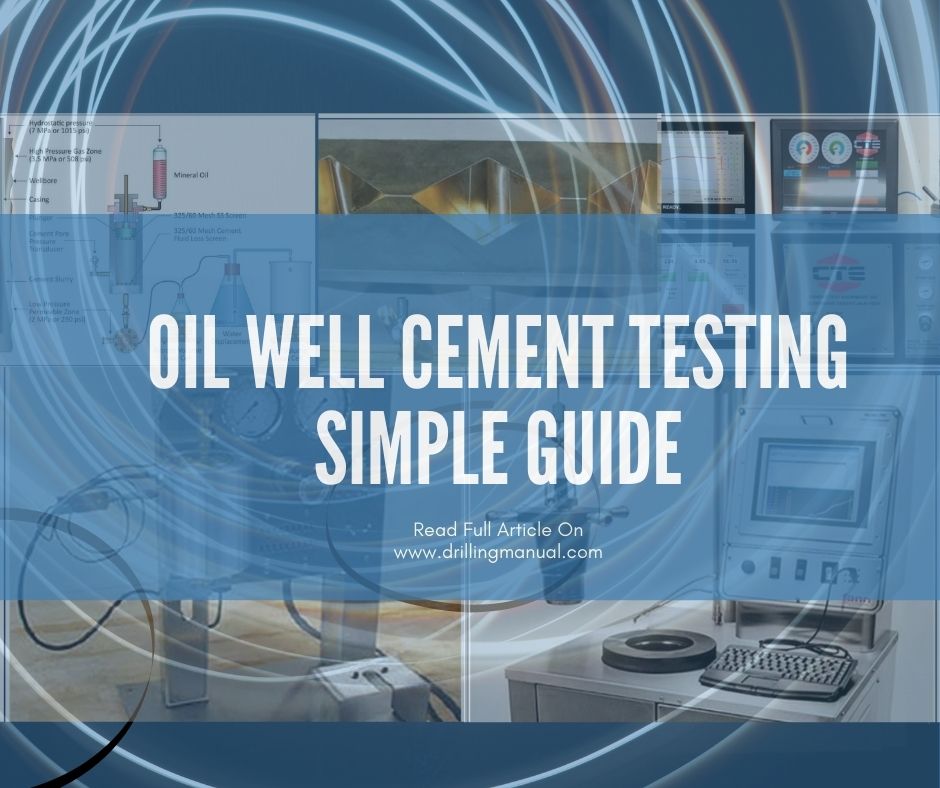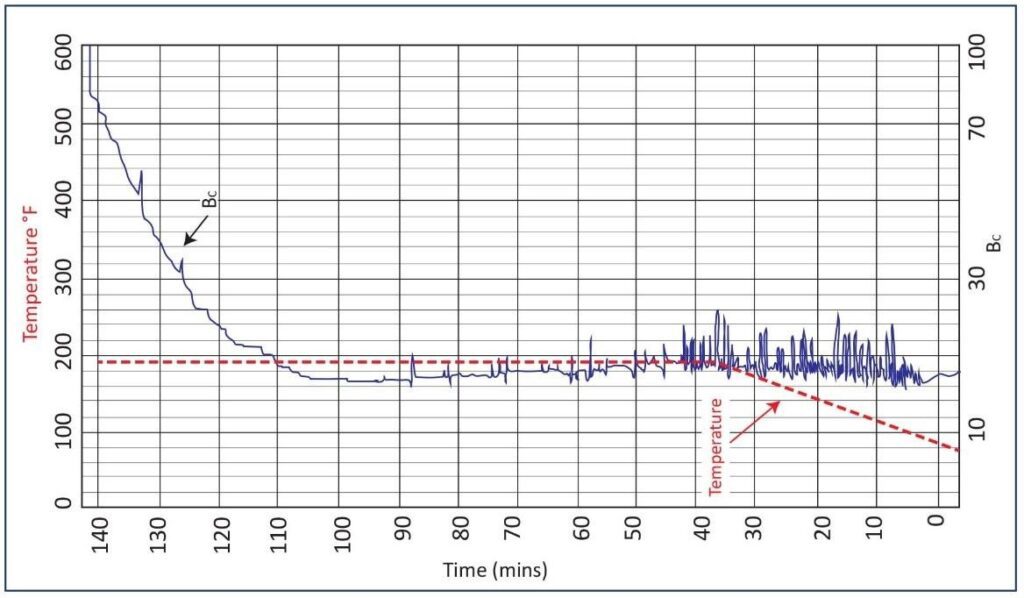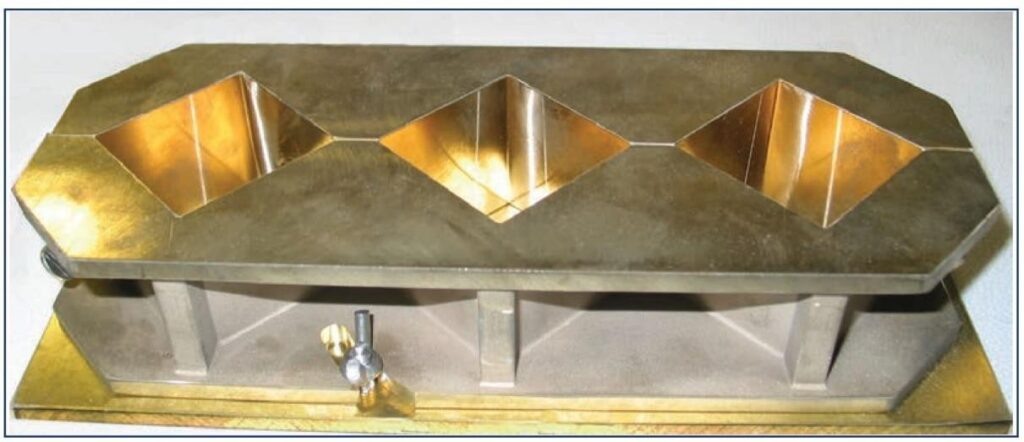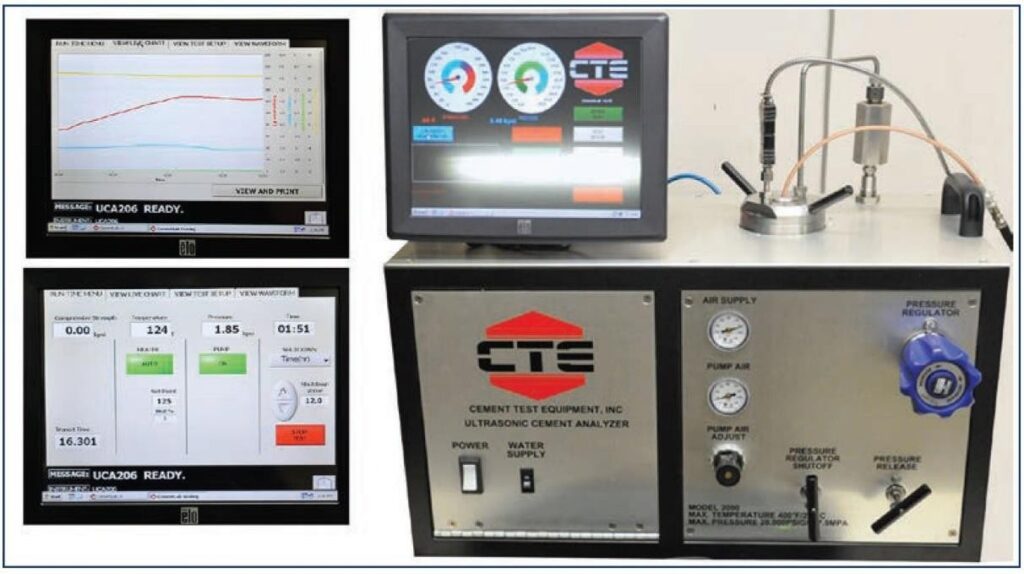
Prior to cementing in drilling oil & gas job, laboratory testing must be carried out to ensure that the correct recipe is used considering all of the existing conditions and cementing additive properties (oil well cement properties) according to API Recommended Practise.
Testing must be conducted on the actual on-site material to be used. The importance of representative sampling and correct handling during testing cannot be over-emphasised. Cement will have significant variations between batches. Fresh water that normally forms the basis for mix water may vary in its chemical composition (such as tannins or chlorides) and this can affect setting times.
Thickening or Pumping Time
Lab testing of a cement slurry is performed to ensure it will remain pumpable in oil and gas wells for long enough for it to be mixed and then displaced down the casing and out into the annulus. Hydration time is measured with a high-pressure high temperature consistometer.

The slurry is placed into a test cell with a diaphragm and a freely rotating paddle. The cell is placed within the test chamber, which applies pressure and temperature during the test period. The viscosity of the slurry is measured continuously by the paddle and recorded as dimensionless Bearden consistency units.
- The time during which the slurry viscosity stays below 30-40 Bc units (is defined as the pumpable time.
- The thickening time is taken to be when the slurry reaches 70 Bc units of consistency (some Operators use 50Bc).
- On reaching the end of the scale at 100 Bc the slurry will resemble modelling clay and will prove almost impossible to move mechanically in a wellbore.

Compressive Strength Testing For Oil Well Cement
Cement requires a minimum compressive strength of 3,450 kPa (500 psi) for most operations. In oil and gas, the original API well cement testing required moulded samples of slurry to be crushed after a series of setting times (e.g. 8, 16 or 24 hours).

An alternative technique uses an ultra-sonic cement analyser (UCA). The liquid slurry is poured into a test cell that is subjected to temperature and pressure. Over the test period (usually about 24 hours) the time for an ultrasonic pulse to pass through the sample is measured. As the cement gels and sets the transit time changes. This is correlated to compressive strength development through a mathematical model built into the controlling unit. This test method is also used to calibrate cement evaluation log responses (check also: Cement Bond Log).

In oil and gas wells, due to the nature of ultrasound, this cement testing method is not suitable for slurries containing foam (Foam Cement) or gas-filled ceramic spheres. Note: ultrasound does not propagate well in gasses
Rheology Testing For Oil Well Cement
Analysis of the rheology of a cement slurry is important for evaluating its pumping and placement efficiency.
The flow properties of a cement slurry are measured in the same way as for drilling fluids using a Fann mud Viscometer.
The rheological properties can be used in software packages to model displacement efficiency and equivalent circulation density (ECD) for pressure control.
Free Water
Free water is defined as the clear liquid that appears on the cement slurry when left to stand. As such it is a measure of the stability of the formulation. A slurry with a high volume of free water is undesirable as this water will collect on the high side of a deviated or horizontal hole, compromising the zonal isolation.
Free water is measured by filling a glass cylinder with slurry and allowing it to stand for a set period (usually about two hours).
Fluid Loss Testing For Oil Well Cement
Excessive loss of water from a slurry will adversely affect the hydration and final strength of cement. The fluid loss of a cement slurry is measured by conditioning the sample at bthe ottom hole circulating temperature before transferring it to an API fluid loss apparatus or HPHT Fluid Loss Unit. The fluid loss cell is fitted at the bottom end with a 325 mesh screen (44-micron openings), supported by a 60 mesh screen. A differential pressure of 70 kPa (1,000 psi) is applied across the sample and filtrate is collected for 30 minutes.
As a rough guide, a slurry required to control gas influx should result in less than 50 ml of lost fluid during this test, one for across a standard oil or water formation, less than 100 ml and for less critical casing strings less than 200 ml is more than sufficient.

Gas Migration/Flow Apparatus
The gas flow model is used for evaluating and testing cement slurries for use in oil and gas well applications where the cement slurry in the annulus between casing and formation is exposed to a high-pressure permeable gas zone and to a lower pressure permeable zone.

The hydrostatic pressure of the fluid on top of the cement plus the hydrostatic pressure of the liquid cement will prevent gas invasion from occurring. During the cement hydration process, the hydrostatic pressure on top of the slurry is relieved thus reducing the cement pore pressure. As the cement sets, the cement pore pressure can allow gas to enter the cement column. The gas can migrate in to the well and to the surface and may cause a well blowout or gas can communicate to a lower pressure permeable zone resulting in an internal blowout. The gas flow model will
simulate this second scenario as described above.
A steel cylinder is used to contain the cement slurry and to simulate the cement in the annulus. Three pressures are applied to the cement slurry during the test:
- Pressurised mineral oil simulates the hydrostatic pressures of different fluids, like drilling mud or cement spacer.
- Nitrogen gas is injected into the cement slurry, a mesh screen will simulate the pressure permeable gas zone
- Back pressure on the system is adjusted through a control valve
- The third pressure is applied with the use of a back-pressure regulator. A fluid loss screen in conjunction with the back-pressure simulates the low-pressure permeable zone.
Cement slurries can be tested at bottom hole temperature for fluid loss, transition time and the permeability of the set cement to resist gas invasion.